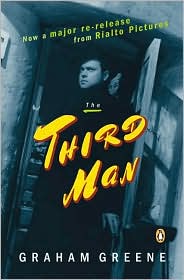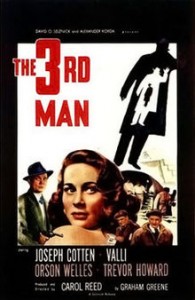1949: when “fear outweighed comedy” in occupied Vienna.
 Written originally as the outline for the screenplay of the famous 1949 film of the same name, Greene sets the story in Vienna just after World War II, employing the sectors established by the conquering British, Americans, French, and Russians to provide tension, mystery, and an almost palpable aura of menace as residents and visitors alike must deal with four different governments, four sets of officials, and four collections of laws as they move throughout the city. With massive bomb damage, the city is still emerging from devastation. Black markets, selling everything from food to penicillin, abound.
Written originally as the outline for the screenplay of the famous 1949 film of the same name, Greene sets the story in Vienna just after World War II, employing the sectors established by the conquering British, Americans, French, and Russians to provide tension, mystery, and an almost palpable aura of menace as residents and visitors alike must deal with four different governments, four sets of officials, and four collections of laws as they move throughout the city. With massive bomb damage, the city is still emerging from devastation. Black markets, selling everything from food to penicillin, abound.
Rollo Martins, the author of cowboy novels written under the name of Buck Dexter, arrives in Vienna to visit an old school friend, Harry Lime, only to find that he has arrived on the day of Lime’s funeral. Investigating Lime’s death, Martins learns that a neighb or saw the traffic accident that killed Lime and observed three men carrying Lime’s body from the scene. Only two of those men have been identified–the third man has vanished.
or saw the traffic accident that killed Lime and observed three men carrying Lime’s body from the scene. Only two of those men have been identified–the third man has vanished.
As Martins investigates, he must deal with the city’s several different governments, each of which has carved out a sector. The initial co-operation among sectors has vanished, and co-operation with the Russian sector is almost non-existent. Wanted men use the city’s sewers to escape from one sector to another, where they cannot be followed. The investigation of Lime’s death becomes more complex when an inebriated Martins is sure that he has seen Harry Lime on the street.
By turns exciting and dar kly humorous, the novel is a curiosity among Greene’s entertainments, since this story was never written to be a novel at all. Intensely visual in its descriptions and action, it lacks the characterization and thematic focus which one associates with most of Greene’s work. The novel’s dialogue, rather than narrative, conveys the story, as it does in the film, and the setting in a war-torn city adds to the sense of danger and drama. Certainly not one of Greene’s “finished” novels, it is still fun to read, especially when one is familiar with the even better film of it, directed by Carol Reed and starring Orson Welles, Joseph Cotton, and Trevor Howard. Of particular interest to those studying writing and film-making, Greene’s novella is full of wit and dark theatrics, and includes everything from a chase through the sewers to a love story.
kly humorous, the novel is a curiosity among Greene’s entertainments, since this story was never written to be a novel at all. Intensely visual in its descriptions and action, it lacks the characterization and thematic focus which one associates with most of Greene’s work. The novel’s dialogue, rather than narrative, conveys the story, as it does in the film, and the setting in a war-torn city adds to the sense of danger and drama. Certainly not one of Greene’s “finished” novels, it is still fun to read, especially when one is familiar with the even better film of it, directed by Carol Reed and starring Orson Welles, Joseph Cotton, and Trevor Howard. Of particular interest to those studying writing and film-making, Greene’s novella is full of wit and dark theatrics, and includes everything from a chase through the sewers to a love story.
Also reviewed here: OUR MAN IN HAVANA and THE POWER AND THE GLORY
Notes: A YouTube video of scenes from the film of The Third Man is here: .
